The Huntington’s blog takes you behind the scenes for a scholarly view of the collections.
Winter Blooms
Posted on Tue., Dec. 22, 2015 by
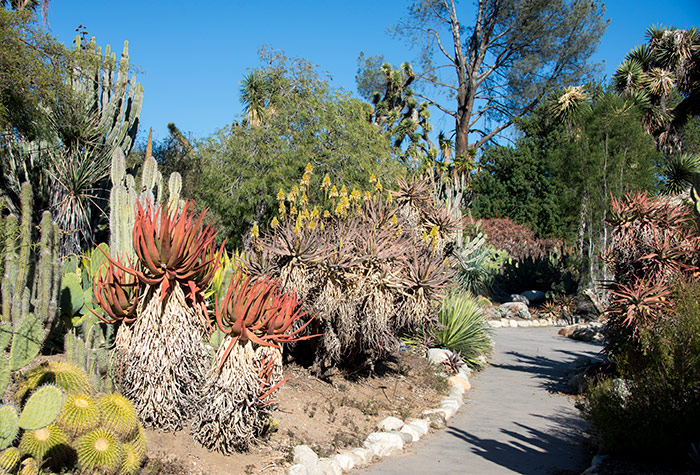
The Desert Garden is particularly vibrant in winter. Drought has concentrated the levels of anthocyanin pigment, casting a red hue in plants such as Aloe pluridens, foreground. Photo by Kate Lain.
While most of the country braces for freezing temperatures and snow, many people in Southern California welcome the arrival of winter as their favorite season. Nighttime temperatures rarely fall below freezing and daytime highs often nudge their way into the 70s.
The Huntington’s botanical collections also seem to relish this time of year, rewarding visitors with a delightful spectacle of blooms. Here’s a taste of what’s on view.
The Desert Garden has turned crimson—or many of its leaves have. The combination of extremely dry conditions coupled with cool nights and warm days has created especially colorful foliage in many species of Aloe, Echeveria, Kalanchoe, and Sedum. The intense color is caused by a concentration of anthocyanin pigments, a sort of suntan for plants. (If you entered through the Oxford Gate, you may have noticed a whole bank of this same red glow in Aloe × principis, a hybrid between A. arborescens and A. ferox.)
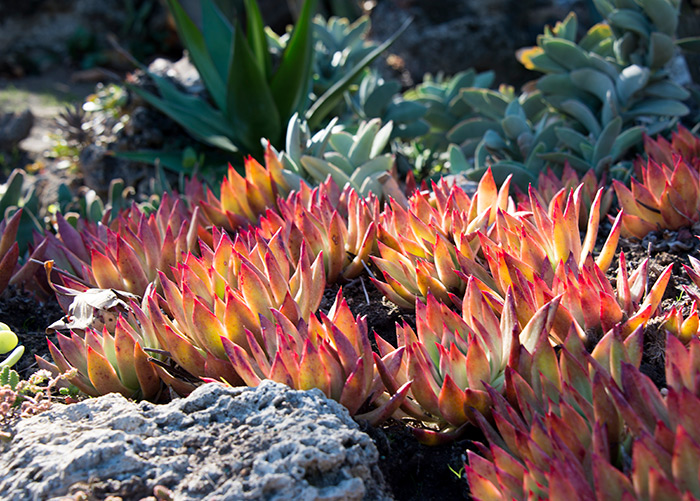
The red tinge of Echeveria agavoides x E. colorata, is even more pronounced this year. Photo by Kate Lain.
To see an entire hillside turned red, head to the Desert Garden’s “Aloe Hill,” where scores of A. arborescens live. (To reach it, walk down the hill past the huge barrel cacti until you see a boulder on your left indicating the Heritage Walk. Take either path to its end.) Enjoy the red leaves now, but return in February when A. arborescens puts on a spectacular show of spikey, red-orange flowers.
Camellias are also winter bloomers. The most concentrated showing of camellias right now is in the north canyon, the area on either side of the road leading from the Chinese Garden to the Japanese Garden. Take the road that starts just beyond the Boone Gallery and walk toward the Japanese Garden. Look on either side to see Camellia hiemalis ‘Showa-no-sakae Benten’ with its variegated leaves and pink blooms, the snowy white blooms of C. sasanqua ‘Snowfall’, and the simple and deep red color of C. ‘Red Tulip’.
When you reach the main entrance of the Chinese Garden, take a detour to see what is perhaps the most important camellia of them all. In a green pot in the northwest corner of the courtyard by the café, you’ll find C. sinensis. Though its small white blooms may seem unremarkable, this plant’s leaves are used to make green and black tea.
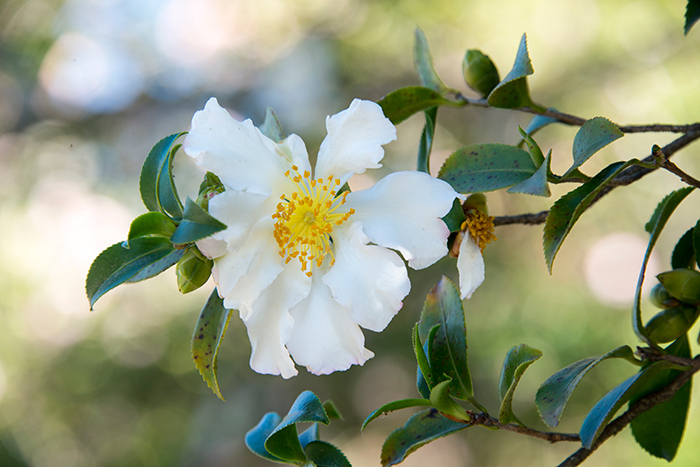
Camellias of all shades are in bloom. The papery white single flowers of Camellia sasanqua ‘Wave Crest’, can be seen across from the main entrance of the Chinese Garden. Photo by Kate Lain.
Another area for camellia viewing is the North Vista, the grassy area ringed by European statuary with the San Gabriel Mountains as a backdrop. Right now, you can see several camellias in flower near the North Vista’s tempietto. These include C. japonica ‘Fashionata’—a reliable bloomer with large, shiny green leaves—and C. hiemalis ‘Bonanza’ with crimson flowers, a musky scent, and petals that flutter to the ground, creating a carpet of blooms. Continue on the gravel paths on the west side of the North Vista to see the origins of camellia—the wild form of C. japonica. Its small, simple, reddish-pink blooms are prized for their understated elegance.
From there you’re in striking distance of the South Terrace of the Huntington Art Gallery, where you’ll see a form of poinsettia (Euphorbia pulcherrima) you won’t find in local nurseries. This tall, shrub-like poinsettia has deep color and graceful stems that poke up over the top of the terrace railing. Its origin is a bit of a mystery, though it’s most likely a hybrid from the 1970s.
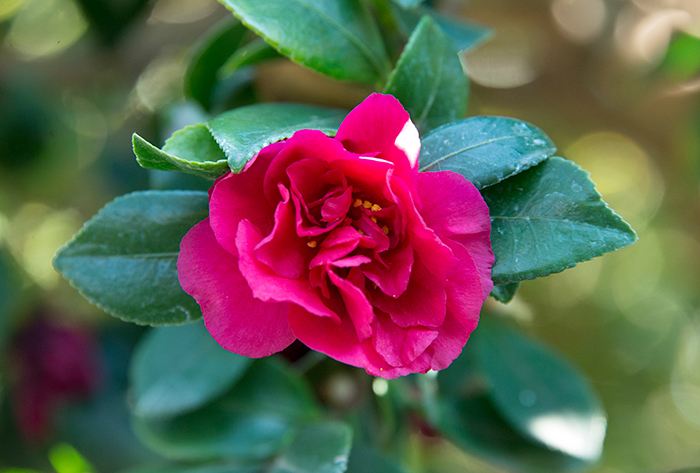
The crimson flowers of Camellia hiemalis ‘Bonanza’, have a musky scent, and petals that flutter to the ground, creating a carpet of blooms. Photo by Kate Lain.
From an informal survey of Huntington garden curators, here are some other favorite winter blooming plants.
Duck into the Rose Hills Foundation Conservatory for Botanical Science and locate the Cloud Forest Room. That’s where you’ll find the Stenorrhynchos speciosum orchid. Its green speckled leaves and intense red blooms will have you thinking of Saint Nick.
South of the Scott Gallery Loggia, you’ll find a great plant made better. Agapanthus is a garden favorite in Southern California, but its bloom-time is limited to May and June. Not so with the repeat-blooming Agapanthus ‘Deja Sky Blue’. This hybrid starts blooming in October and keeps pumping out flower spikes through the winter and well into spring.
Near the Munger Research Center, look for Kniphofia ‘Christmas Cheer’, an evergreen plant with spikes of reddish-orange tubular flowers, introduced by The Huntington in the 1970s.
Lastly, take a gander at one gardener’s joy: the dark green leaves and striking blue flowers of Ceanothus ‘Joyce Coulter’ at the edge of the stroll garden near Alexander Calder’s bright red sculpture, Jerusalem Stabile.
Winter is not only a great time for observing what’s in bloom, but also one of the best times for planting. Happy holidays and—if the mood strikes you—happy gardening!
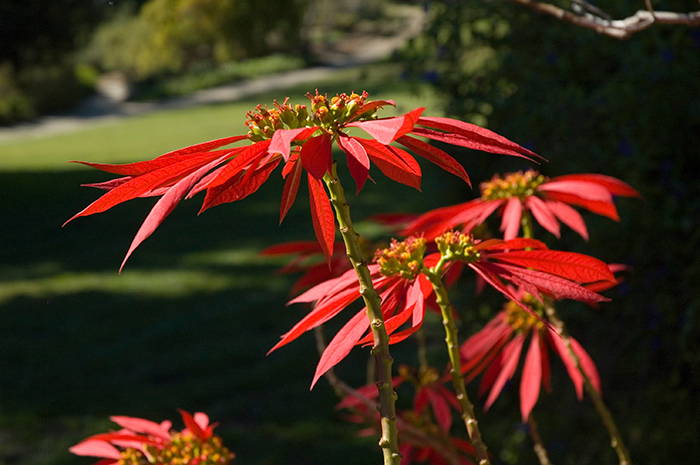
The Euphorbia pulcherrima off the South Terrace of the Huntington Art Gallery is unlike the poinsettia you’ll find in nurseries. Photo by Lisa Blackburn.
Diana W. Thompson is senior writer in the office of communications and marketing at The Huntington.